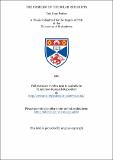Files in this item
The problem of the solar red shifts
Item metadata
| dc.contributor.advisor | Freundlich, Erwin | |
| dc.contributor.author | Forbes, Eric Gray | |
| dc.coverage.spatial | 210 p. | en_US |
| dc.date.accessioned | 2018-06-26T14:44:38Z | |
| dc.date.available | 2018-06-26T14:44:38Z | |
| dc.date.issued | 1961 | |
| dc.identifier.uri | https://hdl.handle.net/10023/14628 | |
| dc.description.abstract | The problem of interpreting the small systematic displacements of solar absorption lines towards longer wavelengths relative to the corresponding laboratory wave-lengths – the so-called solar red shifts – has ranked as one of the most controversial problems in solar physics ever since its discovery by Jewell in 1896. The observational and theoretical difficulties which confronted the pioneer workers in this field are reviewed in Chapter I of this thesis. The year 1920 marks the beginning of a new phase in the development of the problem, since this was when Saha introduced his Ionization Theory which formed a completely new conception of the physical conditions prevailing in the solar atmosphere. At the same time, the announcement that an eclipse experiment made in 1919 appeared to confirm Einstein’s prediction regarding the value of the light deflection, encouraged the belief that the gravitational red shift was implicit in the observed values of the solar red shifts; consequently, the latter were taken as resulting from a superposition of this predicted displacement upon the Doppler effects of radial currents in the solar atmosphere. The validity of this relativity-radial current interpretation is examined in Chapter II on the basis of observational data presently at our disposal. Our survey serves to show that, although many features of the solar red shifts can be explained by assuming that the steady state of the solar atmosphere is being maintained by a microscopic circulation associated with the solar granulation, the well-established observational fact that the absolute (Sun-arc) displacements are generally in excess of the relativity value at the edge of the disk (where the Doppler effects should vanish) is in contradiction to the conventional interpretation. This difficulty was fully appreciated by Professor Freundlich, who held the opinion that it might arise as a result of attempting to fit the observational data into a framework to which they did not rightly belong. It was this attitude which stimulated Freundlich (1954) to propose his revolutionary hypothesis that the red shifts observed in stellar spectra were produced as a result of some unknown interaction mechanism whereby light loses energy as it travels through space. Since this view did not appear to be compatible with the existence of the gravitational red shift, it was considered to be of the utmost importance to analyse the solar red shift data – which were much more reliable than those based on stellar observation – without taking it for granted that this effect existed, and determine whether the observed value supported Freundlich’s interpretation. This was the original object of the present research, begun in September 1955. The major results of the initial two years’ work carried out by the writer in collaboration with Professor Freundlich at the Department of Astronomy of St Andrews University are contained in the three reprints from the Annales d’Astrophysique which are submitted along with this thesis: they appear to confirm the validity of Freundlich’s hypothesis, at the same time revealing no indication of the predicted gravitational red shift. Nevertheless, it was recognised that these conclusions were necessarily based upon a relatively small amount of observational material, and efforts were made by the writer to collect additional data with a view to investigating in more detail the observational properties of the solar red shifts, with particular reference to their dependency upon wavelength and excitation potential. Chapters III and IV are concerned with a description of the observational programme carried out with this intent at the Osservatorio Astrofisico di Arcetri, Italy, and the Universitäts-Sternwarte, Göttingen during the three-year period between October 1957 and September 1960. Much has happened during this time, however, which has cause us to reconsider the problem of the solar red shifts in an entirely different light. The present viewpoint is expressed in Chapter V. | en_US |
| dc.language.iso | en | en_US |
| dc.publisher | University of St Andrews | |
| dc.subject.lcc | QC455.F7 | |
| dc.subject.lcsh | Spectrum, solar | en |
| dc.title | The problem of the solar red shifts | en_US |
| dc.type | Thesis | en_US |
| dc.contributor.sponsor | Department of Scientific and Industrial Research (DSIR) | en_US |
| dc.type.qualificationlevel | Doctoral | en_US |
| dc.type.qualificationname | PhD Doctor of Philosophy | en_US |
| dc.publisher.institution | The University of St Andrews | en_US |
This item appears in the following Collection(s)
Items in the St Andrews Research Repository are protected by copyright, with all rights reserved, unless otherwise indicated.

